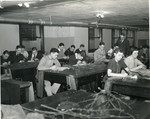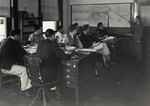
Dean of Science Francois Gilfillan introduced Russian language study to Oregon State College's foreign languages curriculum in the early 1940s and taught it as part of the Army Specialized Training Program (ASTP) curriculum during World War II. (SCARC)
Due to the conditions of the home front in World War Two America, changes in education were necessary. This new rhetoric may have had little to do with the actual outcome of the war.[1] However, this was a symbolic and unifying idea which brought the whole nation together. Although, these changes in education cannot be attributed solely to the war, had there been no war, they would have likely occurred. The war was the catalyst which allowed these changes to happen.[2]
After the war ended the emphasis on how to live in a democracy continued. This was done through “the study of the social studies-history, civics, economics, sociology and geography.”[3] It was coupled with an international understanding, which broadened the horizons of learning in American schools. This international understanding was done through studying different languages, cultures, and achievements of other peoples. "Effective study by many people in the United States of the languages of other peoples in the world is a necessary part of world understanding."[4]As for the study of mathematics, the New York Times reported that there would be a “bottleneck in mathematics just as surely as in machine tools.”[5] This bottleneck also served to emphasize the importance of work in the war industries as well. The most popular source which was quoted during the war was a letter written in response to an inquiry of a University of Michigan professor concerning the importance of mathematics education to Admiral Chester W. Nimitz, who was the Chief of the United States Navy Bureau of Navigation, in October, 1940.[6] The U of M professor was hoping to receive statements which would support the study at secondary and collegiate levels.
Nimitz reported that “75% of the failures in the study of navigation must be attributed to the lack of adequate knowledge of mathematics.”[7] He went further to say that a candidate for a soldier cannot be regarded as adequate if he does not have sufficient knowledge of mathematics and cognitive processing. Admittance standards even had to be lowered in 50% of admissions in order to compensate for this deficiency.[8] This was especially true for the Navy.
Math education was restructured after it suffered in the interwar period because it was previously considered a subject with little value.[9] With the start of war, mathematics was now deemed patriotic and therefore worth studying. Different aspects and applications of math were found in the different branches of the military and for machine use and planning in factories. During the war, math lost much of its abstract nature because “teachers were urged to make their subject matter more practical and directly applicable by including problems based on wartime situations arising from the military, industrial, and home fronts.”[10] They would also “address students’ natural interest in the unprecedented world situation and help them feel useful participants in the war effort.”[11] Ideally, it would also provoke students to be more willing to actively participate in the war effort then, and after they finished their schooling and went on to work in a factory or other war industry, or joined the Army.
Physical education on the other hand was to prepare students physically, particularly males, for a career in the military. Although, just like mathematics, physical education had suffered in the interwar period (1919-1939) and in order to prepare students for life in the military, a new program had to be instituted.[12] This targeted the important and necessary aspects of life in the military, and the home front factories. These men and women needed to be able to work hard and efficiently.
This new emphasis on a practical application, in order to prepare young men for a life in the military, to the physical education curriculum is no surprise as physical education has long been associated with the military and nationalistic sentiment in America. [13] This is especially so in times of national conflict and war. It was during the war that “physical education became more widely established, stabilized and solidified in the curriculum of American secondary schools than it had been in the interwar years.”[14] These changes would remain in years to come, because of physical educators drives to legitimize the curriculum in secondary education during the Second World War.
The new programs contrasted with the old ones which were centered on team games and sports. This new program included “more vigorous activities…conditioning activities…and mass participation.”[15] This restructuring would also help to improve the physical state of the military, which Franklin Delano Roosevelt found to be lacking in September 1941.[16] Two years later in another inspection in the spring of 1943, this had changed. These men were no longer the same overweight and soft young men who looked like little boys playing with BB guns. Essential to this curriculum, was also the students’ participation in extracurricular and interscholastic athletic events. This helped to develop in them an understanding of offensive and defensive movements necessary in military battle tactics.[17]
As integral as the changing curriculum was to the war effort, the end goal was still a life after the war ended. The switch towards applying math skills from war time to peace time applications began as early as 1944, although, some proposals had appeared before this.[18] Some proposals even appeared as early as the United State’s entry into the war in 1941. This illustrates the country’s assumption of an Allied victory, and its drive and determination to see it come to fruition.[19]
Changes in education at the collegiate level were approached differently than at the other levels of education. Most discussed changes which would take place in the wake of the war, and these new ideas were proposed concerning the structure of learning in college. In this ‘new college,’ emphasis would be placed on accommodating those who would be returning from the war, these students or teachers would hold new views on the world around them which they acquired during their time overseas. These “men and women demobilized from the armed forces and war industries [should] be given opportunity to secure necessary retraining for civilian activities, or to continue their education in cases where it was interrupted by the war.”[20]
There were three main ways the new colleges could be structured:
1. The emphasis could be placed on a study of classics in which some students would be able to find guidance from the past for the future. This would allow to those who fear the many changes which could take place in colleges and society as a whole.
2. Secondly, the focus could be on core classes in American history, mathematics, physics, and foreign languages. This would be complemented with a tough curriculum throughout all of the colleges’ courses; the harder the curriculum the better it is for the student.
3. Lastly, education would be based more on the self-education and not merely on lectures.[21]
Ultimately, these new college students would be expected to take their learning into their own hands if they wished to succeed in each course and later in life.
There was an unprecedented growth in the number of students pursuing higher education in the years following World War II.[22] This growth was perhaps the most successful change due to the war.[23] Marvin Lazerson illustrates this point when he writes,
Few industries grew as fast, gained as much prestige, or affected the lives of so many people. Higher education received remarkable sums of money from federal and state governments; alumni and foundations also gave generously. Families reached into their savings, postponed purchases, and went into debt so that their children could go to college. Higher education came to simultaneously embody both a public good-beneficial to the nation's economy, protective of its national defense, opening up new avenues of knowledge, and able to realize equality of educational opportunity-and a private benefit, so that everyone who possessed it substantially improved their access to higher income, status, and security.[24]
These values can be further seen in the postwar belief of the perfect family. Were the mother does not have to work because the father can support the family and their modern house with all the necessary technologies and appliances.
This increase in college attendees can be assumed to be promoted by the GI Bill and in the years after V-J Day, veterans accounted for approximately 70% of the male population enrolled in college.[25]
[1] Alan Wayne Garrett, “Secondary school mathematics curriculum rhetoric during World War II” (PhD diss., The University of Texas at Austin, 1991): 9.
[2] James Willard Morris, III, “Fit to Fight: America’s secondary school physical education curriculum during World War II” (PhD diss., The University of Texas at Austin, 1997), vii.
[3] “Science Joins Three R's,” The Science News-Letter 55.17 (Apr. 23, 1949): 262.
[4] Ibid.
[5] “The Mathematical Tool,” New York Times, August 26, 1941, C18.
[6] Garrett, 43.
[7] Admiral Chester W. Nimitz quoted in: Garrett, 43.
[8] Ibid.
[9] Ibid., vii, 15.
[10] Ibid., viii.
[11] Ibid., 35.
[12]Morris, 1.
[13]Ibid., 38.
[14]Ibid., 26.
[15]David K. Brace, “Physical Fitness in Schools and Colleges” Journal of Health and Physical Education15 (November 1944): 490.
[16] Doris Kearns Goodwin, No Ordinary Time Franklin and Eleanor Roosevelt: The Home Front in World War II, (New York: Simon & Schuster, 1994), 425.
[17]Morris, 30.
[18] Garrett, 15.
[19] Ibid., 17.
[20] Floyd W. Beeves and D. L. Harley, “The National Resources Planning Board Report on Education,” The High School Journal 26. 4 (May, 1943): 115-116.
[21] Constance Warren, “A New College for a New World: Miss Warren says that students and faculty returning from war will demand a different kind of education,” New York Times, Feb 13, 1944.
[22] Ibid., 64.
[23] Ibid., 67.
[24] Ibid., 65.
[25] John Bound and Sarah Turner, “Going to War and Going to College: Did World War II and the G.I. Bill Increase Educational Attainment for Returning Veterans?” Journal of Labor Economics 20.4 (October 2002): 785.


